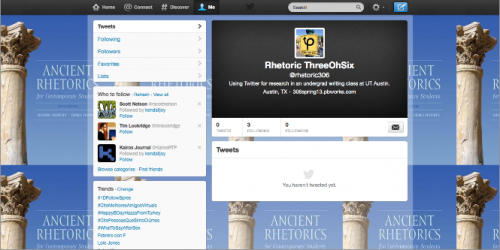You are here
Researching a Controversy using Twitter
Primary tabs

Class Twitter account, @rhetoric306, with Ancient Rhetorics for Contemporary Students (5th ed.) as background
By creating their own Twitter accounts and finding accounts to follow that are related to their research topic, students learn the difference between library resources and online resources like daily news, blogs, and opinion.
Research, digital literacy
Students need a computer (or conceivably, smartphone) with internet access to sign up for a free Twitter account. When I taught this lesson in a computer mediated classroom, I had a projector screen to introduce students to Twitter.
Students created their own Twitter accounts in class, and I asked them to follow our class Twitter account right away. I use the class account to retweet my students and make short announcements. Then, I asked students to find an active Twitter account (with recent tweets) that is relevant to their research topic. I asked students to follow the account, then tweet the handle of thtat account to our class account. I also asked students to come up with a class hash tag.
I also gave students some research guidelines (see Instructions for Students, below) to help them think about the relationship between library resources, with their slower editorial gatekeeping process, and online resources, and the different research strategies required to use both.
Creating a class Twitter account can help keep students organized around a central account. I also recommend reading about what other instructors are doing to come up with a mix of ideas that suits your class. Some recommended reading is included in the additional resources, below.
These are the instructions I gave my students:
Your first Twitter assignment is as follows:
- Create your own professional Twitter account (or if you're not shy, you can use a Twitter account you already have).
- Follow our class Twitter account, @rhetoric306, and tweet us to introduce yourself online (your name and the issue you're researching would be helpful!).
- By Friday at 2 pm, you need to find an active Twitter account (with recent tweets) that is relevant to your issue. Follow them, then tweet their handle and how you found them to our class account. I'll use the class account to follow your recommendations!
- We're going to need a class hash tag to keep track of our class tweets across our different accounts. When you tweet the account you followed, you should also propose a hash tag by tweeting @rhetoric306. The goals here are short, unique, and informative.
- If you have ideas for how you want to use Twitter in our class, tweet them @rhetoric306.
Some Twitter guidelines:
- You can only tweet 140 characters at once.
- You create a link to other Twitter accounts when you put their handle, like @rhetoric306, in your tweet.
- Hash tags help categorize your tweets for searches. #likethis
- Although Twitter created a way to re-post someone else's entire Tweet (called retweeting), many people often still edit or comment on the tweet and post it again using the marker "RT" to credit the original poster.
- If you can't figure out how to do something, try to Google it.
- NB: Using Twitter puts us in contact with people outside of class. Obviously, we have no control over what these people say or share. If you find yourself uncomfortable with any Twitter content for any reason, you may unfollow or block any user, and disregard any comments, conversations, or links. Please come to me if you have any questions or concerns about this.
Some Twitter/Research guidelines:
- Don't just go with the first thing you find. The goal is to find high-quality sources. Even just one quality Twitter account will give you much better returns than a dozen mediocre ones. Look through lots of Tweets (30-50) from each account, and look through lots of accounts before you decide who to follow.
- Think about your search terms. You can search for words that appear in tweets, but you can also search for hash tags and usernames. And there are more ways to search Twitter than just the interface they provide you. Get creative.
- Try to find experts and advocates. Journalists may be excellent news, but you also need opinion, and sometimes organizations or even scholars will have useful tweets.
- Follow the links. Read what they are reading, check out who they are re-tweeting, surf their hash tags. Twitter doesn't use MLA, citing sources in such a way that your readers can recognize and locate the originals is still important.
- Experiment. Whether it's on Twitter or on the Library site, effective research requires some creativity and experimentation. You have to try things out, and don't be disappointed if you don't what you want on the first try--use your failed and frustrated searches to figure out how to do it better.
I evaluate my class using the Learning Record, and I have students complete brief reflective writing exercises on what they learned each class.
I admit, I was surprised at how many of my students were not already using Twitter. I wished I had left more time and given them more detailed instructions on the first day I introduced it. But, I also think Twitter is relatively easy to learn. A technological challenge can also foster student collaboration, since they pose questions and help each other figure out how to solve the problems that inevitably arise.
- My post on Twitter at Blogging Pedagogy: http://bloggingpedagogy.dwrl.utexas.edu/content/researching-public-issues-twitter
- Grad Hacker on Teaching with Twitter: http://www.gradhacker.org/2012/11/26/teaching-with-twitter/
- Matt King's RHE 312 Twitter Assignment: http://rhe312.pbworks.com/w/page/21055220/Twitter%20Assignment
- The Learning Record: http://www.learningrecord.org/
I used this lesson in my introductory writing course, RHE 306 Rhetoric and Writing.
-

- Log in to post comments

